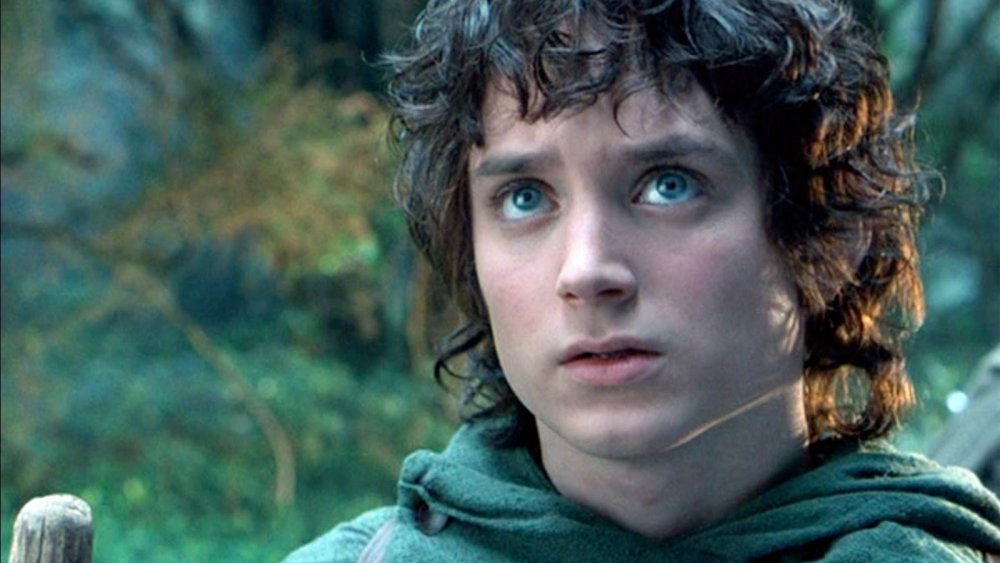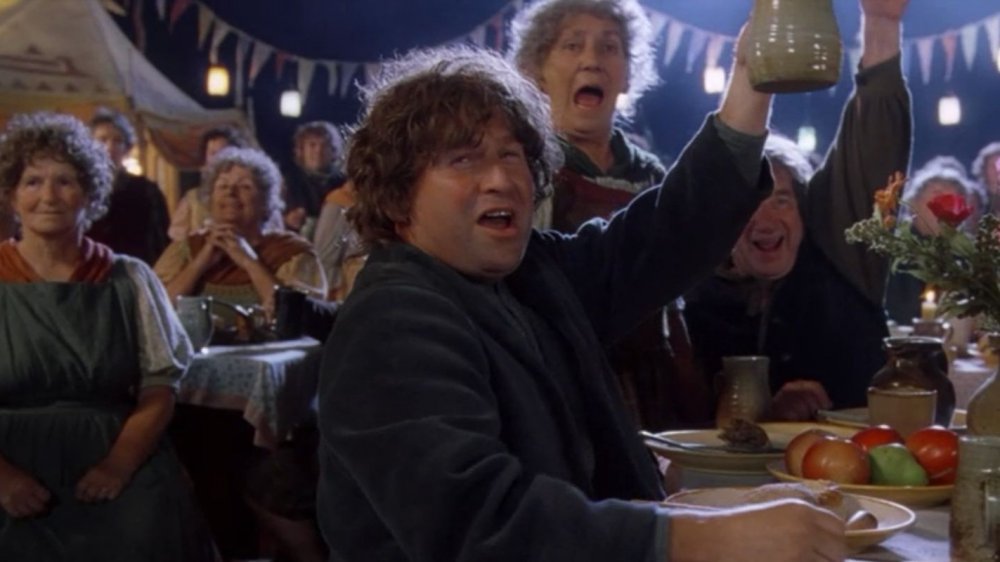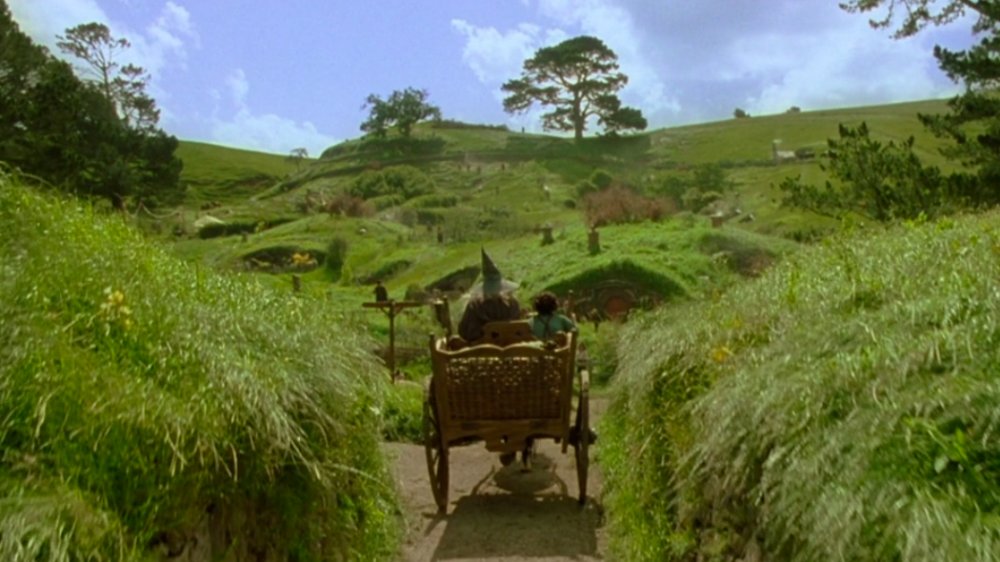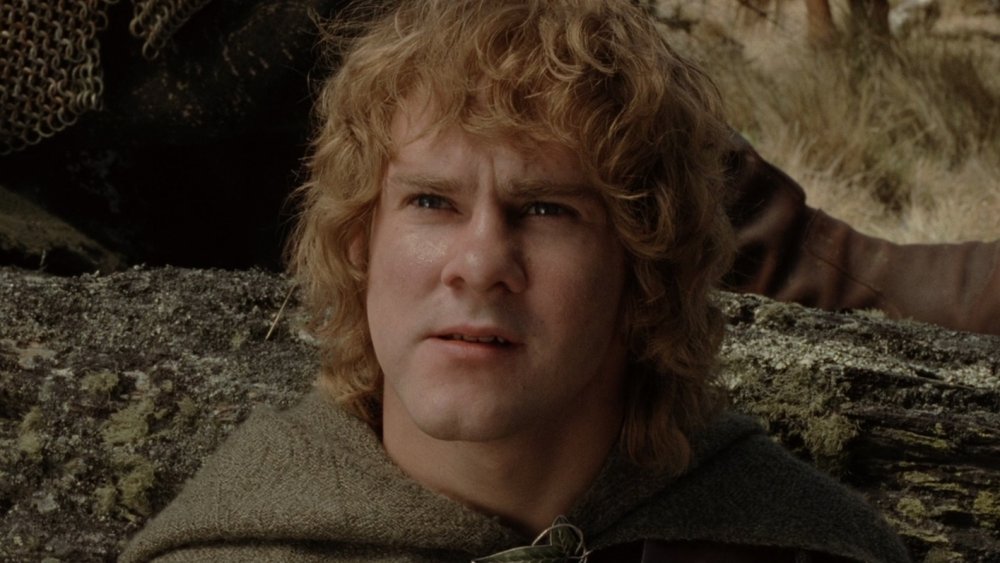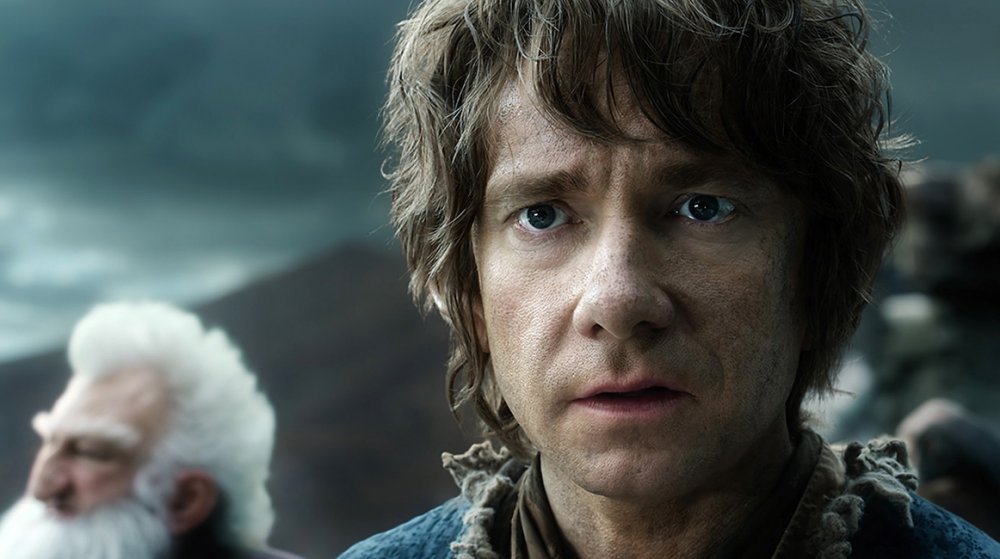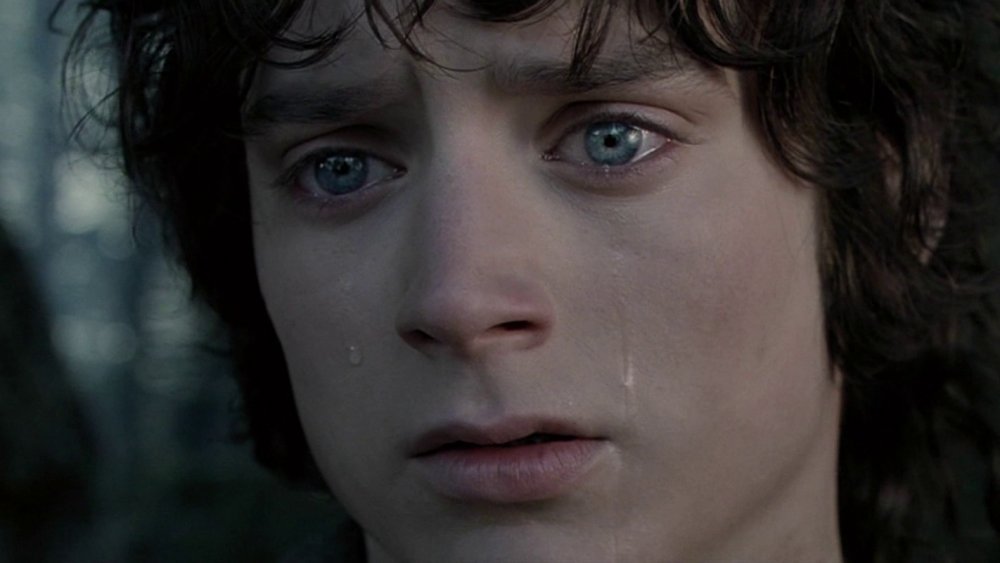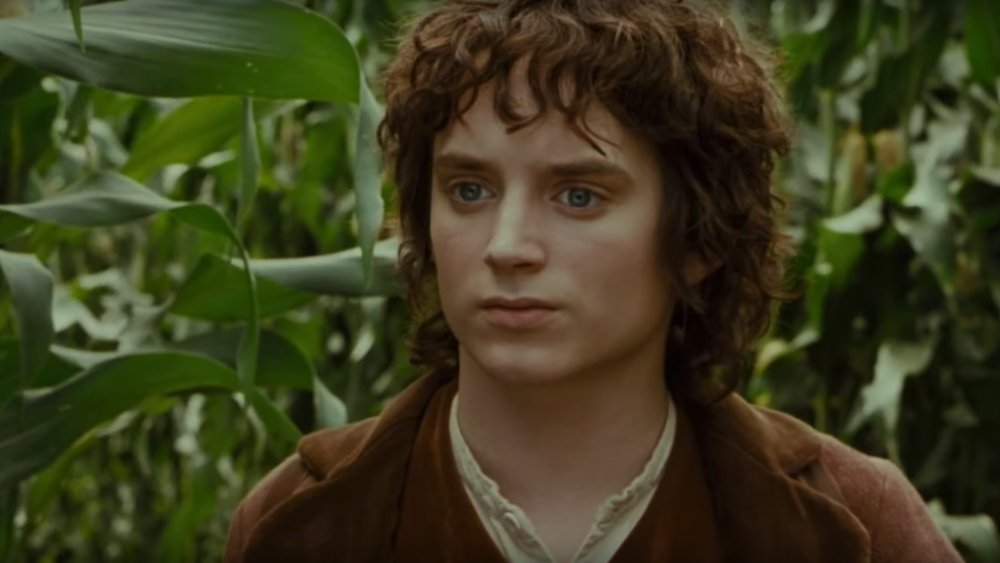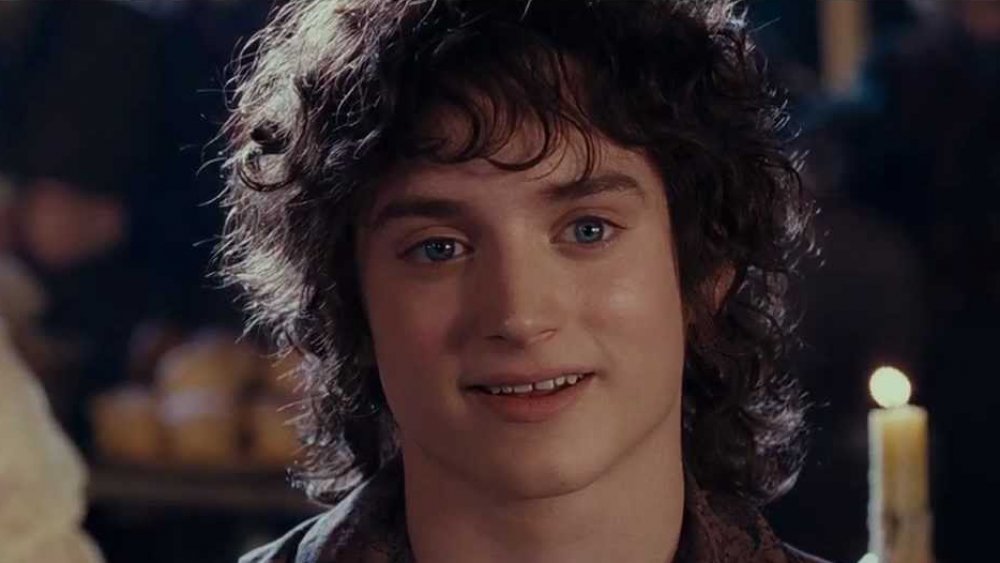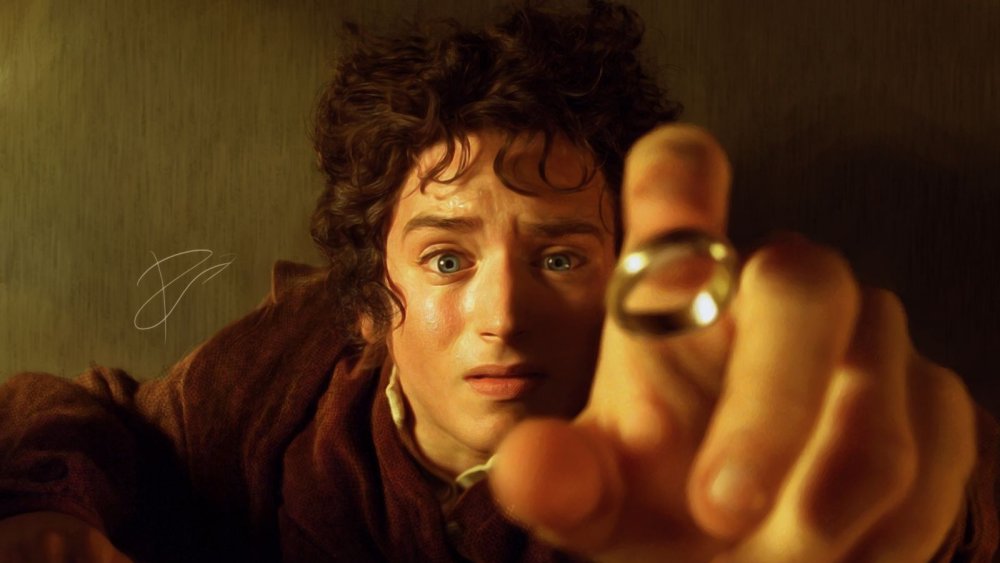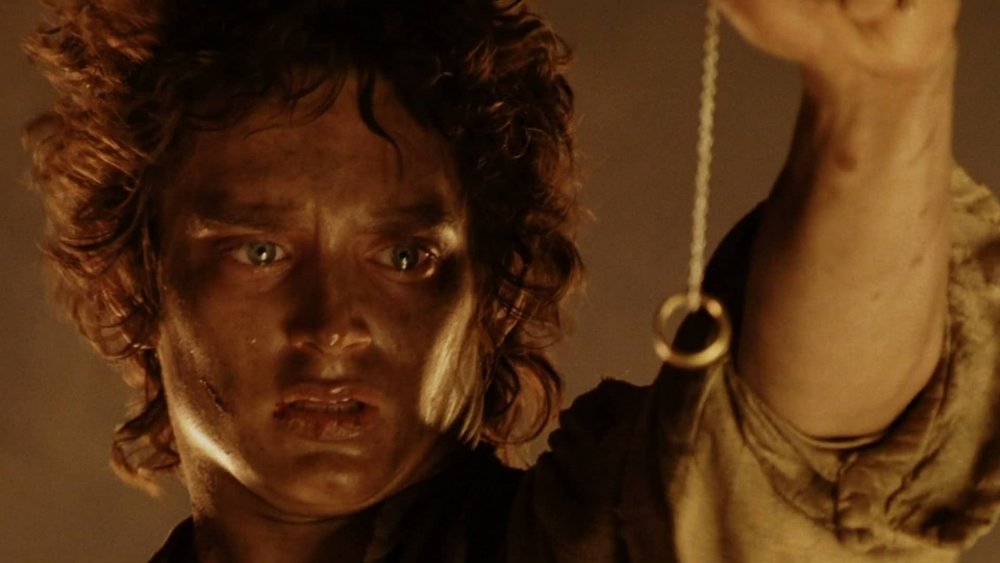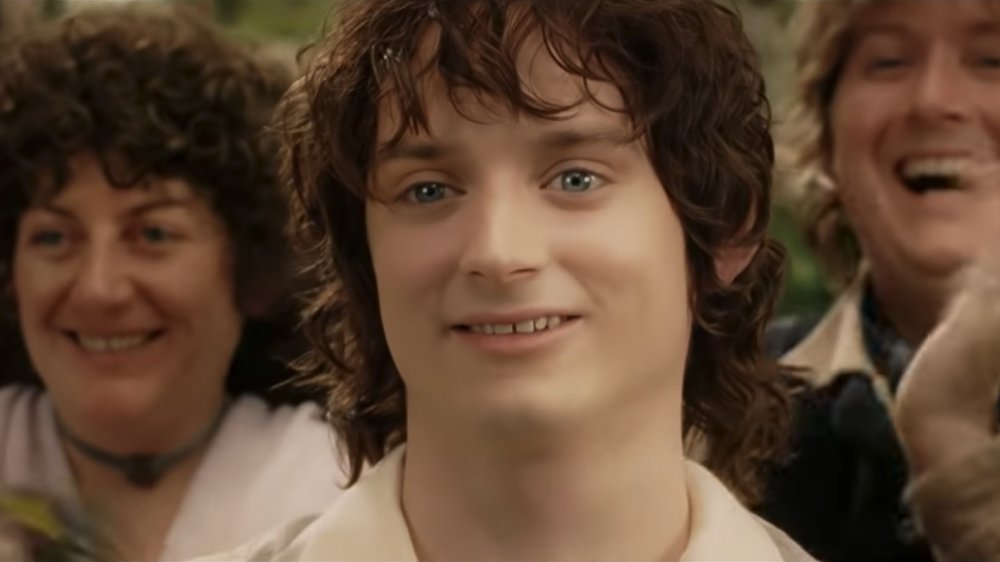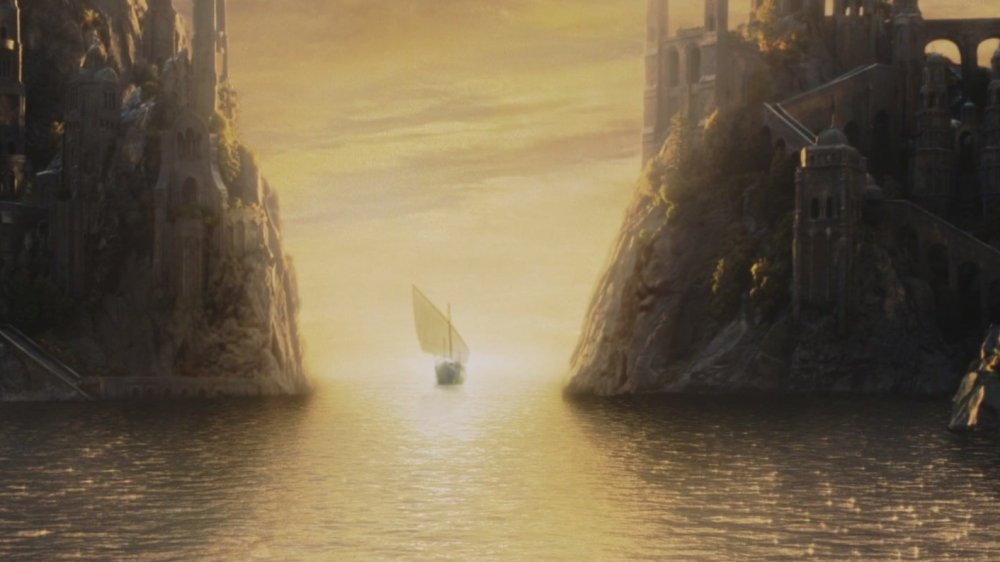Frodo Baggins' Entire Backstory Explained
If there's one group of creatures that is most closely associated with J.R.R. Tolkien's works, it's his own invented race of Hobbits. While they don't appear much in his older Middle-earth writings such as The Silmarillion or Unfinished Tales they figure prominently in The Lord of the Rings and, well, The Hobbit — seriously, it's in the name. Both of these stories focus heavily on Hobbits, following their adventures and enabling the reader to experience things from a Hobbit-size perspective.
Out of all of the Hobbits that Tolkien ever wrote about, there are two in particular that capture the collective imagination — two small yet valiant, tender but tough Halflings. We're talking, of course, about Bilbo Baggins and Frodo Baggins, the relatives who serve as the focal points of each story. In The Hobbit, Bilbo finds the One Ring and helps to bring an end to Smaug the Golden and the goblins of the Misty Mountains.
As impressive as Bilbo's story is, though, Frodo is pretty special too. Elijah Wood's portrayal in Peter Jackson's cinematic adaptation may come across as a bit distracted and distant, but that's because he's playing a character that is literally being consumed from the inside out as he tries to step up and save the world by destroying the One Ring. Here is the complete backstory that led to Frodo of the Nine Fingers playing such a crucial role in Middle-earth history.
Concerning Hobbits
In order to truly understand Frodo's origins, it's worth zooming out a bit to consider the culture that he grew up in. Tolkien goes to great lengths throughout his writing to highlight the quiet yet profound differences that make Hobbits distinct from the Dwarves, Men, Elves, and wizards that surrounded them on all sides — quite literally.
It's rumored, though not confirmed, that Hobbits are distantly related to men, although they rarely fraternize with "the Big Folk" as they call them. Early on in their history, Hobbits are split into three large subgroups. The Stoors get along with Men fairly well, enjoy boating — which is uncommon for Hobbits — and can even grow facial hair. The Harfoots are best buds with the Dwarves and are the first Hobbits to initiate the custom of living underground. The Fallohides like the Elves and are the most adventurously tempered of the bunch.
Hobbit culture is well-known for its relaxed, rural nature. The "Little People" don't like machines or industry, preferring a humble life with plenty of access to good food and drink. In the prologue to The Fellowship of the Ring, Tolkien explains that "Hobbits are an unobtrusive... people... for they love peace and quiet and good tilled earth: a well-ordered and well-farmed countryside was their favorite haunt."
In spite of this aversion for new things, Hobbits are still very dexterous, skilled, and industrious when they want to be. They can see and hear better than most Men, and, of course, they're famously short, typically topping out between two and four feet tall.
Settling the Shire
Hobbits' earliest history stretches back to the beginning years of the Third Age. At this point in time, they live in the northeastern region of Middle-earth (roughly between Mirkwood and the Misty Mountains). This puts them in close proximity to the original lands of the Rohirrim, as is testified to in The Two Towers when King Théoden explains that the legends of Rohan include "halfling folk that dwell in holes in sand dunes."
As the dangers increase around them, the different clans of Hobbits begin to gradually move west in search of greener pastures, with each group lazily finding its own path over the Misty Mountains. As an interesting side note, it's likely at this point in their history that a few of the Stoors stay behind, living near the Great River, Anduin. This inadvertently sets the stage for Gollum's early life centuries later as a distant Hobbit relative of the Stoors who breaks bad when he finds the One Ring.
As they move west, many of the Hobbits settle in the area around Bree — the town with the Prancing Pony inn from The Fellowship of the Ring. It's not until the year 1601 of the Third Age, though, that a large number of Halflings officially colonize the area that would become known as the Shire. Once settled, these Hobbits and their descendants more or less continue to live comfortably for many centuries, until the events of the War of the Ring painfully shake them back into reality.
The Brandybucks
When the Hobbits arrive in the Shire they initially become part of the slowly collapsing kingdom of Arnor — a nation of men and the sister kingdom of Gondor. The Hobbits even claim to have sent archers to help with one of Arnor's wars. However, when that nation finally crumbles nearly 500 years later, the Shire Hobbits branch off on their own and become autonomous for the next thousand years.
As an independent group, the Hobbits elect one of their own, called the Thain, to lead them. The first Thain, Bucca of the Marish, becomes the founder of the Brandybuck family, and after a few hundred years, one of his descendants actually leads his family out of the Shire to colonize a neighboring plot of land that becomes known as Buckland. From then on, while intimately connected with the Shire, Buckland operates on its own, virtually as a small, independent country.
Frodo's mother, Primula Brandybuck, hails from this small yet spunky colony of Hobbits. Fans of Peter Jackson's trilogy will also recognize Buckland's main village, Bucklebury, from when it's referred to by Merry Brandybuck in The Fellowship of the Ring film when the Hobbits escape the Black Riders by crossing on the Bucklebury ferry.
The Bagginses
While Frodo's maternal family may have functioned as self-governing outsiders, his paternal family is full-on Shire Hobbit stock, born and bred. They're also a significantly younger family, historically speaking. In fact, the first Baggins, Balbo Baggins, shows up not much more than a century before Bilbo is born.
While the Bagginses quickly proliferate throughout the Shire, they are mostly concentrated around the village of Hobbiton. They intermarry with other powerful Hobbit families, including the Tooks and the Brandybucks, which makes Frodo, Pippin, and Merry all distant cousins. Bagginses are also famously seen as well-to-do folks who never get into trouble or have unexpected adventures. The only notable exceptions are those who have Tookish blood, as that branch of the family tends to be prone to more of an adventurous attitude than the others.
While the Baggins family has a less prestigious pedigree than the Brandybucks, Frodo's father's family is still a well-known Shire staple by the time the Ringbearer shows up on the scene.
An orphan
Frodo Baggins, the child of Drogo Baggins and Primula Brandybuck, is born on September 22, in the year 1368 of the Shire Reckoning (in other words, counting from the founding of the Shire in 1601 of the Second Age).
In The Fellowship of the Ring Sam Gamgee's father, the Gaffer, explains that the little family spends a good deal of their time in Buckland. This is largely due to the fact that Frodo's father is a great patron of good food, and the Master of Buckland is famous for his well-stocked dinner table. Unfortunately, this proclivity for delicious food sets the family up for an untimely tragedy.
One evening, probably after a pleasant dinner, Frodo's parents decide to go out boating in the moonlight. While they're on their romantic excursion, they tip out of the boat and both drown — again, most Hobbits are infamously bad with all things having to do with water. It isn't long before multiple versions of the story begin to circulate, with some saying that Drogo's enormous weight sunk the boat, while more sinister rumors claim that Primula actually pushed her husband in and he pulled her in along with him. Whatever the specifics, the event leaves the doubtless traumatized Frodo orphaned at a very young age.
Raised in Buckland
After his parents' death, Frodo spends the bulk of his youth being raised in Brandy Hall, a massive underground Hobbit palace of sorts that is constantly swarming with hundreds of his Brandybuck relatives. During this time Frodo establishes himself as a bit of a troublemaker. In The Fellowship of the Ring, the Hobbit known as Farmer Maggot recollects when Frodo was "one of the worst young rascals of Buckland" — a fact that he closely associates with the young fellow's repeated attempts to steal from his crop of prized mushrooms.
Once Frodo enters his early twenties — or his "tweens" as Hobbits call the irresponsible age — he's adopted by his wealthy cousin Bilbo who brings him back to Hobbiton to live with him in his mini-mansion of Bag End. The two Hobbits are technically cousins (Frodo's mother was Bilbo's first cousin and his father was Bilbo's second cousin), but the age difference between the two leads Frodo to refer to his older relative by the moniker "Uncle Bilbo."
The two peas in a pod settle down into comfortable bachelorhood and proceed to lead a carefree life together in their comfy Hobbiton dwelling. Bilbo is 99 years old when he initially adopts Frodo and more than a decade passes in relative peace, which leads us to Bilbo's 111th birthday.
Coming of age
By chance, Frodo and Bilbo both had the same birthday: September 22. In fact, in The Fellowship of the Ring, Bilbo even states this as a condition for why he feels Frodo should come live with him, explaining, "You had better come and live here, Frodo my lad, and then we can celebrate our birthday-parties comfortably together."
Naturally, then, the bachelors have quite the annual to do as they go about hosting perennial joint birthday parties. However, when Bilbo's 111th birthday and Frodo's 33rd birthday happen to fall on the same year, an extra special occasion is planned. See, 111 years is an unusually ripe, respectable old age for a Hobbit to reach, and 33 is the point that Hobbits consider their young ones to have "come of age" — consider it equivalent to the modern 16th birthday party.
The event turns into an even bigger deal when Bilbo chooses this point in time to finally abandon his quiet life once again. He starts by trashing his already shaky reputation amongst his Hobbit neighbors by using the One Ring to vanish before the flabbergasted eyes of his guests. Next, he leaves the powerful piece of jewelry to his heir — along with everything else he owns — and heads off into the blue in search of new adventures. When the dust settles, Frodo finds himself in possession of a supercharged ring and the unexpected new owner of Bag End, where he continues to live his carefree life for the next 17 years.
The Ringbearer
When Frodo turns 50 years old his life explodes. It's at that time that Gandalf the wizard arrives at his doorstep with news that his fancy ring is actually the One Ring that belongs to Sauron, the Dark Lord. The news sparks an epic quest that sweeps the discomfited Hobbit off his feet and leads him on a journey to the still-Hobbit-filled village of Bree, a famous counsel in Rivendell, the dark depths of Moria, the garden regions of Gondor, and ultimately the bleak land of Mordor itself.
Along the way, he overcomes his own fears and learns to accept his calling as the Ringbearer tasked with carrying out the only hope of the Free Peoples of the world: destroying the One Ring in the Cracks of Doom. He tames Gollum along this journey and uses the miserable wretch as a guide to help him and his servant Samwise find a way into Mordor.
The run-in with Gollum ultimately proves to be a fortunate crossing of paths, as when Frodo finally stands at the Cracks of Doom, he finds his own will is unable to destroy the powerful golden ring. Instead, he gives in to the overwhelming temptation and claims it for his own. Also consumed with desire, Gollum chooses that moment to attack Frodo. He bites off his ring finger before he slips and falls, Ring in hand, into the fiery depths below.
Painful wounds
After his harrowing adventures in The Lord of the Rings Frodo (now "of the Nine Fingers") slowly makes his way back to his homeland of the Shire. Fans of the books know that when they get home, Frodo and his three Hobbit companions don't find everything as peaceful as the Jackson films would indicate.
In fact, the Shire is overrun by ruffians backed by none other than Saruman (who is still alive in the books at this point). In response, the quartet of Halflings rallies their fellow Hobbits to resist their oppressors, leading to the ousting of the brigands and the death of both Saruman and Wormtongue.
After these events — along with a good deal of fixing and rebuilding — things settle down and the pre-war status quo is finally restored... that is, for everyone except Frodo. On the anniversary of his being stabbed by the Black Rider on Weathertop, he comments on his wound still aching, adding, "There is no real going back. Though I may come to the Shire, it will not seem the same; for I shall not be the same. I am wounded with knife, sting, and tooth, and a long burden. Where shall I find rest?"
In addition, each year, when the anniversary of the destruction of the Ring rolls around, he falls into a despondent sickness and despair. Simply put, the spiritual toll of bearing the Ring had been so great that Frodo slowly realizes he can never again find true peace in Middle-earth.
The historian
While Frodo's personal life is filled with sorrow and pain during these final years, that doesn't mean he's sitting around twiddling his thumbs. In fact, the retired Hobbit hero stays quite busy. Along with helping with the cleanup, he spends a chunk of time serving as the interim Mayor of Michel Delving, the de facto capital of the Shire, until the previous mayor is recovered from his manhandling by Saruman's ruffians.
Frodo also spends much of his time working on the Red Book of Westmarch. This famous book was begun by Bilbo, who used it to record, among other things, the story of his own adventures. Frodo spends time organizing the manuscript before he adds his own account of the War of the Ring, giving it the long yet epic title The Downfall of the Lord of the Rings and the Return of the King. While Frodo is the primary author of the Red Book, it's eventually also added to in various ways and at different times by Sam, Pippin, and Merry.
Go west, young Hobbit
At last, run down by the exhausting job of simply living at this point, Frodo decides that he's going to leave Middle-earth. After the War of the Ring, Arwen, now the queen of Gondor, had chosen to become mortal and stay with her husband, Aragorn, in Middle-earth — she could do this because of some complicated family history that had to do with her grandfather saving the world back in the days of The Silmarillion.
Since she decides to give up her mortality, Arwen gives Frodo her spot as a passenger on the ships that carry the weary Elves over the western sea to the Blessed Realm — a sort of heaven on earth for the immortal beings. This is an incredible opportunity, as virtually no mortals are allowed to make this journey. However, both Bilbo and Frodo are made an exception to the rule due to their incredible sacrifices as Ringbearers.
Thus, with Arwen's blessing, Frodo passes into early retirement in the West, and Tolkien gives us no further updates about his life on the other side of the water. He simply leaves us with this tantalizing line at the end of The Return of the King: "And then it seemed to him that... the grey rain-curtain turned all to silver glass and was rolled back, and he beheld white shores and beyond them a far green country under a swift sunrise." And that, friends, is the end of Frodo's story in Middle-earth.
